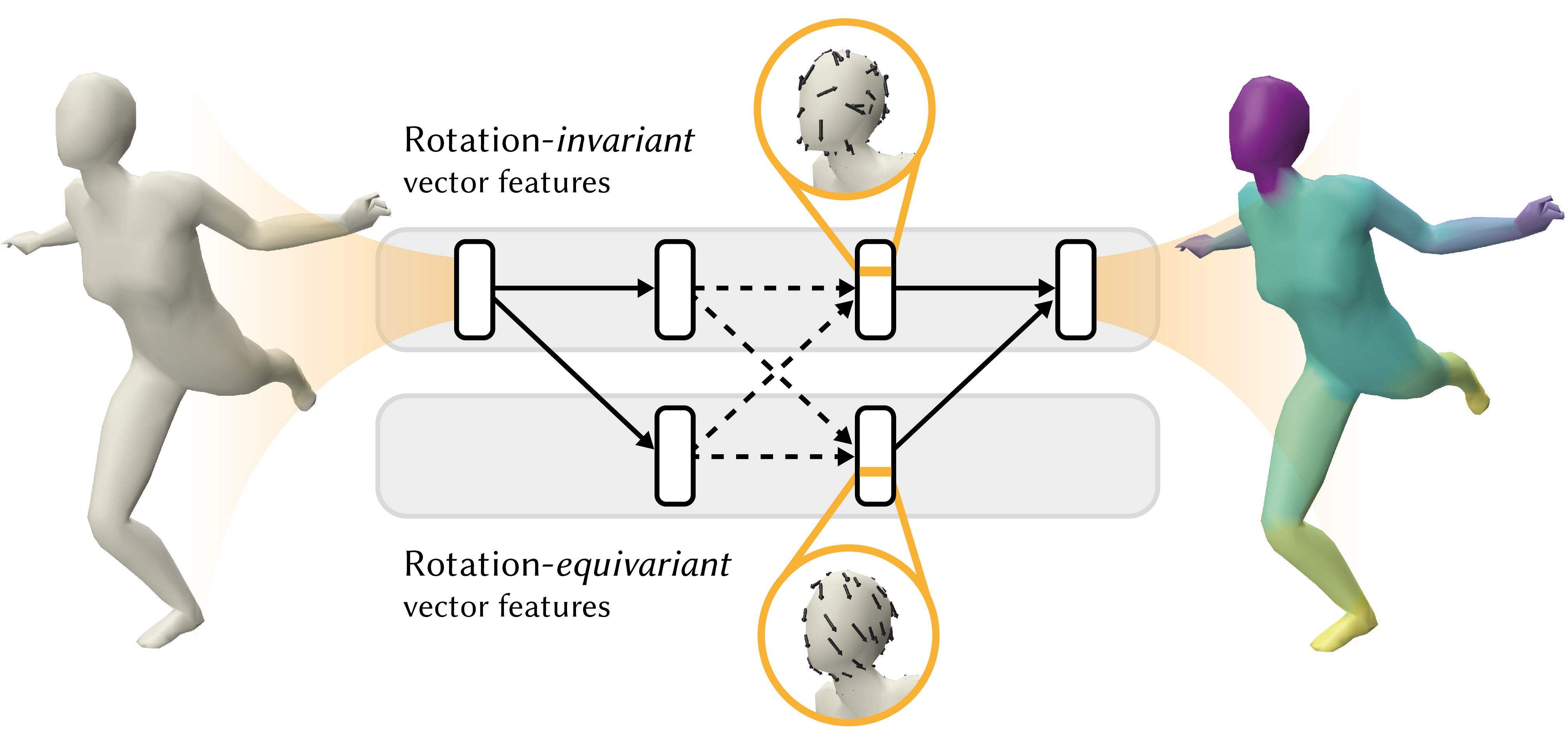Code for Harmonic Surface Networks, an approach for deep learning on surfaces operating on vector-valued, rotation-equivariant features. This is achieved by learning circular harmonic kernels and separating features in streams of different equivariance classes. The advantage of our approach is that the rotational degree of freedom, arising when a filter kernel is transported along a surface, has no effect on the network. The filters can be evaluated in arbitrarily chosen coordinate systems.
This project requires the following dependencies. The version numbers have been tested and shown to work, other versions are likely, but not guaranteed, to work.
- PyTorch 1.5
- PyTorch Geometric 1.4.3 and its dependencies
- Progressbar2
- Suitesparse (used for the Vector Heat Method)
Clone this repository and its submodules
$ git clone --recurse-submodules https://github.com/rubenwiersma/hsn.git
Install the vectorheat python module, explained in the following subsection.
To perform computations on the mesh - e.g. Vector Heat Method, surface area computation, etc. - we use Geometry Central. We have created a small Python binding into a C++ function that computes these quantities globally for each vertex in a mesh. Run the following commands in your shell to install the extension:
$ pip install ./vectorheat
Having trouble building? First make sure that you have the latest version of CMake installed (> 3.10). Next, check that every dependency is present in this repo (pybind11, geometrycentral). If not, you might not have cloned submodules. To fix this:
$ git submodule update --recursive
Suitesparse? When processing shapes with the Vector Heat Method, you might run into a solver error. This is fixed when you build the vectorheat extension with suitesparse. Installation in Linux with:
$ apt-get install libsuitesparse-dev
We have compiled four Jupyter Notebooks to easily replicate the experiments from the paper:
- Shape classification
- Shape segmentation
- Correspondence
- Classification of MNIST mapped to a sphere
These notebooks can be accessed in the root of this repo.
To use the datasets for these experiments, follow these steps:
- Create a
datafolder in a convenient place (notebooks assume the repo root). - Download and unzip the dataset for the experiment you want to replicate and move it to the
datafolder. Note: we've zipped the folder structure for easy drag and drop. The folders contain a zip file that should not be unzipped.- Shape classification (3.4MB) [1]
- Shape segmentation (74.1MB) [2]
- Correspondence (remeshed) (17.4MB) [3]
- Download the original FAUST dataset here [4]
- Classification of MNIST mapped to a sphere (55.8MB) [5]
[1] Haggai Maron, Meirav Galun, Noam Aigerman, Miri Trope, Nadav Dym, Ersin Yumer, Vladimir G Kim, and Yaron Lipman. 2017. Convolutional neural networks on surfaces via seamless toric covers. ACM Trans. Graph 36, 4 (2017).
[2] Zhouhui Lian et al. 2011. SHREC ’11 Track: Shape Retrieval on Non-rigid 3D Watertight Meshes. Eurographics Workshop on 3D Object Retrieval.
[3] Adrien Poulenard and Maks Ovsjanikov. 2018. Multi-directional geodesic neural net- works via equivariant convolution. ACM Trans. Graph. 37, 6 (2018).
[4] Federica Bogo, Javier Romero, Matthew Loper, and Michael J. Black. 2014. FAUST: Dataset and evaluation for 3D mesh registration. In CVPR. IEEE.
[5] Hugo Larochelle et al. 2007. An empirical evaluation of deep architectures on problems with many factors of variation. In ICML. ACM.
Author: Ruben Wiersma
Please cite our paper if this code contributes to an academic publication:
@Article{Wiersma2020,
author = {Ruben Wiersma, Elmar Eisemann, Klaus Hildebrandt},
journal = {Transactions on Graphics},
title = {CNNs on Surfaces using Rotation-Equivariant Features},
year = {2020},
month = jul,
number = {4},
volume = {39},
doi = {10.1145/3386569.3392437},
publisher = {ACM},
}
